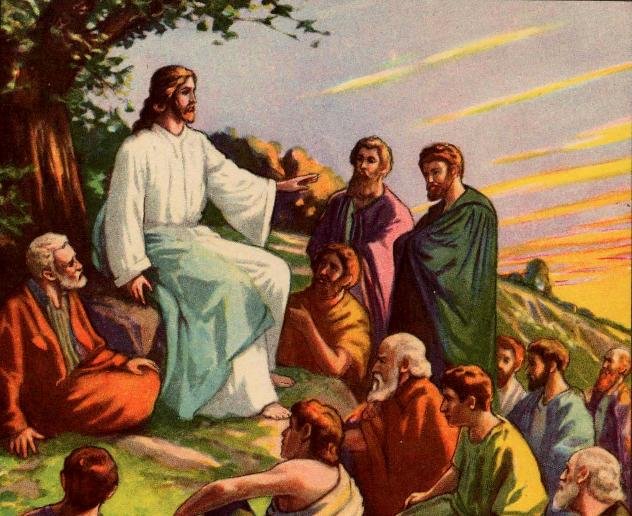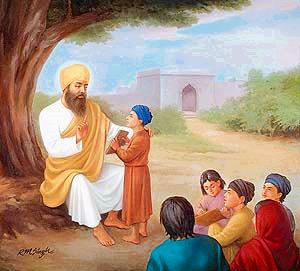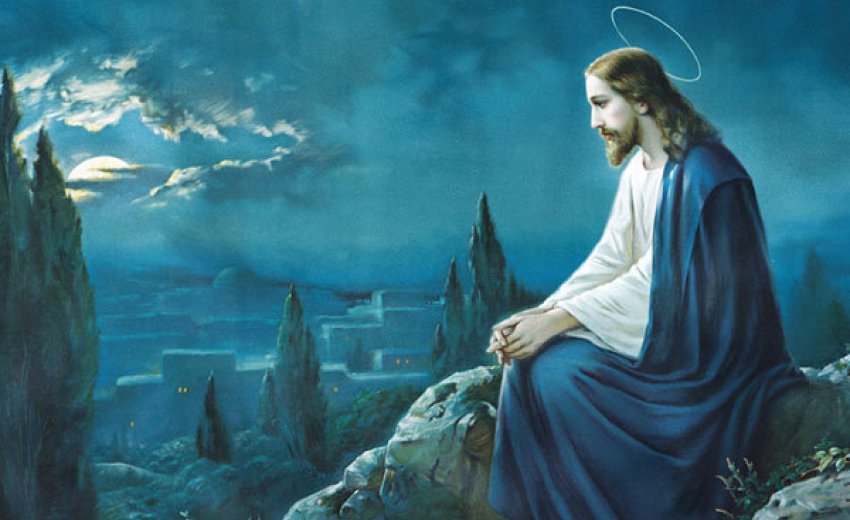 My earliest memories are etched with the physical beauty of Jesus Christ. His blond hair and blue eyes were so different from all the people that I knew in India. I attended a convent school where we recited "Our Father" during the morning assembly, and we took courses on Moral Science. Most of all I loved going into the Convent where we sang psalms and collected beautiful images of Christ, and of Our Lady of Fatima, after whom my school was named.
My earliest memories are etched with the physical beauty of Jesus Christ. His blond hair and blue eyes were so different from all the people that I knew in India. I attended a convent school where we recited "Our Father" during the morning assembly, and we took courses on Moral Science. Most of all I loved going into the Convent where we sang psalms and collected beautiful images of Christ, and of Our Lady of Fatima, after whom my school was named.
At home of course it was a different matter. It was a Sikh household in which the centre of life was the Guru Granth. The holy book is regarded as the divine revelation and utmost respect is paid to it. As children we'd help our parents dress the Book in silks and brocades. It was put on a pedestal while we sat on the floor in front. We recited its passionate poetry patterned on the raga system of ancient India. At home we heard bout the life of the Ten Sikh Gurus who did not look like Jesus Christ.
And yet life was not schizophrenic, for the two worlds with their different languages, different histories, different images and different styles of worship co-existed colourfully. Together they became an essential part of my psyche. The "question" of identity never came up: just as I knew my name, I knew I was a Sikh. But that did not stop me from participating excitedly in the religious space created by my Catholic teachers: it was mysterious and enchanting in its own way.
I can still feel the fervour with which I would sing "The Lord is my shepherd nothing shall I fear" - in spite of my desperately poor musical talents! But when I came to finish High school in America, I saw Christ pervading the fabric of western society and my own tradition extremely distant. As the only "brown" student in an all "white" girls' school, I became more conscious about my identity. I recall reading Walt Whitman's Passage to India, and beginning my journey home. This American poet, who viewed himself in the role of Christ, impelled me to explore my Sikh heritage.
Ironically then, the more I grew up in a Christian environment, the more consciously Sikh I became, with the result that Jesus of my childhood imagination got blurry and lost. Growing up in postcolonial Punjab, I did not think very deeply about the Sikh Gurus, and now that I am living in this part of the world, I must admit that I didn't think very seriously about Christ. So to look at Christ from a Sikh perspective today is indeed an interesting and challenging assignment. As I try to do so the figure of Jesus from the multidimensional world of my childhood resurfaces - giving me much joy and enrichment. Who is Jesus Christ? I see him as a wonderful parallel with the person of Nanak, the first Sikh Guru. There is no direct connection between Christ and the Sikh Gurus. They do not intersect each other. The two form separate and distinct temporal and spatial points in our history, but when we look closely at them, they illuminate each other. By looking at them as parallel phenomena, we not only learn more about the founders of Christianity and Sikhism, but we also get a better sense of ourselves, of our neighbours, and of the world we live in.
Who is Jesus Christ? I see him as a wonderful parallel with the person of Nanak, the first Sikh Guru. There is no direct connection between Christ and the Sikh Gurus. They do not intersect each other. The two form separate and distinct temporal and spatial points in our history, but when we look closely at them, they illuminate each other. By looking at them as parallel phenomena, we not only learn more about the founders of Christianity and Sikhism, but we also get a better sense of ourselves, of our neighbours, and of the world we live in.
Both Christ and Nanak are remembered in almost identical ways. Churches resound with hymns like "Christ is the light of the world," and Sikh Gurdwaras with "satgur nanak pragatia miti dhundh jag chanan hoia" - "as Nanak appeared, mist and darkness disappeared into light." The powerful and substanceless light used across cultures and across centuries reveals the common patterns of our human imagination.
Jesus and Nanak ushered a way of life that was illuminating and liberating. It is interesting that both claimed they had no control over their speech. Spontaneously, effortlessly, they revealed what they were endowed with. According to the gospel of John: "I do not speak of my own accord... what the Father has told me is what I speak" And Guru Nanak, "haun bol na janda mai kahia sabhu hukmao jio" - "I don't know how to speak, I utter what you command me." In each case, then, the Divine is the Voice.
Their message too bears a striking resemblance. Against ceremonial rituals and orthodox formalities, both Jesus and Nanak directed their followers to the human condition. For them cleanliness did not reside in external codes and behavior; it was an inner attitude towards life and living. Just as Christ denounced the superiority of all those who walked about in long robes, Nanak denounced those who wore loincloths and smeared themselves with ashes. Most importantly, both Jesus and Nanak showed us the path of love. In the Gospels Jesus says, "The greatest commandment of all is this - love your God with all your soul, mind and strength, and love your neighbour as yourself." In the same vein, the Sikh Gurus applauded love as the supreme virtue, "sunia mania, manu kita bhau." Bhau or love is passionate and takes lovers to those depths of richness and fullness where there is freedom from all kinds of prejudices and limitations. But we need to put their words in practice. Love for the Divine would open and expand us towards our families and neighbours; it would enable us to cast aside racism, sexism, and classism so prevalent in our contemporary society. We need to remember their message of love for all our "neighbours" - high and low, black and white, men and women too.
Most importantly, both Jesus and Nanak showed us the path of love. In the Gospels Jesus says, "The greatest commandment of all is this - love your God with all your soul, mind and strength, and love your neighbour as yourself." In the same vein, the Sikh Gurus applauded love as the supreme virtue, "sunia mania, manu kita bhau." Bhau or love is passionate and takes lovers to those depths of richness and fullness where there is freedom from all kinds of prejudices and limitations. But we need to put their words in practice. Love for the Divine would open and expand us towards our families and neighbours; it would enable us to cast aside racism, sexism, and classism so prevalent in our contemporary society. We need to remember their message of love for all our "neighbours" - high and low, black and white, men and women too.
In fact Christ revealed himself first to Mary. Throughout his ministry, he healed and helped women, and reminds us of "mother's joy" that a human being has been born into the world. The Mother is an important figure in Sikh scripture, for the transcendent One is both father and mother, and Guru Nanak repeatedly points to the womb in which we are first lodged. Mother's body and joy, and the earth, our common matrix to which we all equally belong, are celebrated throughout the sacred scripture of the Sikhs. But of course, memory is selective and the patriarchs with their access to the words of Christ and Nanak have remembered, interpreted, and kept them for themselves. It is important that each of us begins to see the Christian and Sikh scriptures from our own eyes and experience their rich legacy.
So, who is Jesus Christ for me, a Sikh? In my mind he is an enlightener, and though I may not see him as one of the Ten Sikh Gurus, he is a distinct and vital parallel who continues to play a very significant role in my life as a Sikh. In a way, I trace my happiness and at-homeness in contemporary America because he opened me up to another mode of spirituality at a very young age. He did not take anything away from my being a Sikh. In fact, Jesus Christ concretised the message of Guru Nanak: "Countless are the ways of meditation, and countless are the avenues of love." (Japji, 17). Jesus has been a wonderful mirror who in his unique form and vocabulary promoted my self-understanding.
The image of Christ embedded in my childhood has made the verses of the Gurus alive for me. I can see and feel what Guru Nanak meant: "Accept all humans as your equals, and let them be your only sect" (Japji 28), or Guru Gobind Singh: "manas ki jat sabhe eke paihcanbo" - "recognise the single caste of humanity." However, it also complicates the situation. Coming from the pluralist tradition of Sikhism where the holy book contains not only the verses of the Sikh Gurus but also of Hindu and Muslim saints, and where the Ultimate is received in a variety of perceptions and relationships, I do have problems with the exclusivism of Jesus.
The Sikh Gurus reiterate that Allah and Ram are the same, so is the Muslim Mosque and the Hindu Temple. Emerging historically and geographically between the eastern tradition of Hinduism and the western faith of Islam, Sikhism whole-heartedly accepts both eastern and western perceptions of the Divine, and their various modes of worship. But when Christ alone is declared the Omega Point, or Baptism the exclusive way to the Kingdom of God, then where do I stand? As a Sikh I have no place.
Personally, I find it hard to understand how the God of Genesis becomes the biological father of Christ in the Gospels. According to Genesis, God creates the earth, animals, Adam and Eve - but he remains distant and far away. How can this totally transcendent God become the Father of Christ? How can he beget Jesus?
Now Guru Nanak is not viewed as an incarnation of the Divine; rather, he is an enlightener whose inspired poetry becomes the embodiment of the Transcendent One. I guess the issue of incarnation really troubles me as a Sikh. Creation in Christianity is modelled on a distant artist, more in the sense of a commander-in-chief, rather than on the biological mother who actually bodies forth her offspring.
The Virgin Birth of Christ sends negative messages about our bodies, our world, and of our selves. Now that I think of it, saying "Our Father" in a language that was not my mother tongue did not make me any less committed to Sikhism. But it has left an indelible paternal figure in my imagination, which - in spite of all my Sikh and feminist mental footnotes - still dominates.
I sometimes wonder how my world would have been shaped had I attended a Hindu school and visited goddess Kali's temple, which was close to my home! In post-colonial Sikh society it was safe and secure to go to Convent schools and even attend Catholic services because it was all very "distant." But the Hindu tradition so close geographically, historically, anthropologically, and psychologically, was all too dangerous and threatening.
I find similar fears and phobias now circulating in our contemporary western society. As our world is getting to be a smaller and smaller place we are getting more and more afraid of losing our self, of losing our "identity." So instead of opening ourselves up and appreciating others, we are becoming more narrow and insular. Our tunnel vision makes us grope in darkness. How can we remain afraid and threatened by each others religions? It is not a matter of simple tolerance, and it is not simply mastering facts and figures about other religious traditions, and it is certainly not about converting and conversions from one faith to another. As Jesus resurfaces in my mind, I realise the beauty and power of his personality for me, and I realise the urgency of breaking our narrow mental walls. Just as he entered the imagination of us Sikhs in far away India, Sikhs and others have to enter into the imagination of people here in the West. We have to see the "light" that Jesus and Nanak ushered in for us.
So many Indians, Chinese, Japanese, Africans, Middle-easterners have made their homes here, but how little we know about each other's spiritual worldviews! We may sit in the same classroom, work in the same office, and fly in the same planes, but we remain segregated at a fundamental level. During the first waves of migrations, the racial policies pretty much forced into homogenising matters, and in recent waves, sacred spaces and sacred times are confined to ethnic ghettos and left to their individual communities. The result? We are impoverished. We have lost out on the extremely rich arabesques of images, languages, metaphysics, rituals, music, and poetry and many other wonderful resources of our global society. Sadly, even after century and a half, we are far from fulfilling Walt Whitman's exhortation:
Lo, soul, seest thou not God's purpose from the first?
The earth to be spann'd, connected by network
The races, neighbours, to marry and be given in marriage,
The oceans to be cross'd, the distant brought near,
The lands to be welded together.
Walt Whitman, Passage to India!
We may have triumphed in producing physical and technological networks, but we have failed in creating mental and spiritual links. We need to "weld together". We need to experience the fullness of humanity and the transcendence of the Divine. Together, Christians, Sikhs, Hindus, Muslims, Jews, Buddhists, Jains, men and women, we should relish the plurality and diversity of our human culture.
It is more than a coincidence that Christians and Sikhs celebrate the birth of their communities on the first day of spring - called Easter in northern Europe and Baisakhi in India. Our joint celebration of the annual renewal of life carries on the legacy of Jesus Christ and Guru Nanak

